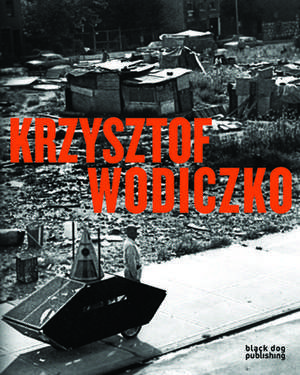Krzysztof Wodiczko
Editat de Duncan McCorquodale Contribuţii de Dick Hebdige, Denis. Hollier, Lisa Saltzmanen Limba Engleză Hardback – 25 apr 2011
Krzysztof Wodiczko’s artistic projects stage a dynamic and vivid encounter between aesthetics, ethics and technology. For almost 40 years, the artist’s powerful and extensive body of work has deployed contemporary technologies to engage with the problematics of alterity, social responsibility and urban experience. Believing that ‘public art’ should perform an ethical interruption of existing social processes and their ideological underpinnings, Wodiczko’s critical interventions in the urban environment have addressed issues of urban violence, homelessness, alienation and wartime trauma.
Since the 1980s, he has produced large-scale slide and video projections, transforming the facades of official buildings and historical monuments into temporary spaces for critical reflection and public protest. The Public Projections series include: The Grand Army Plaza Memorial Arch, Brooklyn, NY (1983), The Hirshhorn Museum, Washington D.C. (1988), The Whitney Museum of American Art, New York (1989), Bunker Hill Monument, Boston (1998), A-Bomb Dome, Hiroshima (1999) and El Centro Cultural, Tijuana, Mexico (2001).
By nature, Wodiczko’s work is often controversial and the book looks at his development of a series of nomadic instruments for both homeless and immigrant operators that function as implements for survival, communication, empowerment, and healing. The Homeless Vehicle project in New York City, equips nomadic ‘evicts’ with tools for self-articulation, whilst the elaborate Xenology instruments are designed to empower the ‘immigrant’ by providing access to speech and figuration in the public realm. Like much of his work, his interrogative designs and portable instruments are animated by a desire to bring the socially opaque into the public sphere of appearances, to restore voice and visibility to those rendered mute within the parameters of the public domain.
Krzysztof Wodiczko is the first full-scale study of the artist’s work, its ethico-political imperatives, and the diverse interpretive lenses which accompany its theorization. Developed in close collaboration with the artist, and bringing together an array of essays by leading scholars from a variety of disciplines, the book represents the most significant and sustained engagement with the artist’s practice to date.
Since the 1980s, he has produced large-scale slide and video projections, transforming the facades of official buildings and historical monuments into temporary spaces for critical reflection and public protest. The Public Projections series include: The Grand Army Plaza Memorial Arch, Brooklyn, NY (1983), The Hirshhorn Museum, Washington D.C. (1988), The Whitney Museum of American Art, New York (1989), Bunker Hill Monument, Boston (1998), A-Bomb Dome, Hiroshima (1999) and El Centro Cultural, Tijuana, Mexico (2001).
By nature, Wodiczko’s work is often controversial and the book looks at his development of a series of nomadic instruments for both homeless and immigrant operators that function as implements for survival, communication, empowerment, and healing. The Homeless Vehicle project in New York City, equips nomadic ‘evicts’ with tools for self-articulation, whilst the elaborate Xenology instruments are designed to empower the ‘immigrant’ by providing access to speech and figuration in the public realm. Like much of his work, his interrogative designs and portable instruments are animated by a desire to bring the socially opaque into the public sphere of appearances, to restore voice and visibility to those rendered mute within the parameters of the public domain.
Krzysztof Wodiczko is the first full-scale study of the artist’s work, its ethico-political imperatives, and the diverse interpretive lenses which accompany its theorization. Developed in close collaboration with the artist, and bringing together an array of essays by leading scholars from a variety of disciplines, the book represents the most significant and sustained engagement with the artist’s practice to date.
Preț: 268.44 lei
Preț vechi: 306.97 lei
-13% Nou
Puncte Express: 403
Preț estimativ în valută:
51.36€ • 53.63$ • 42.51£
51.36€ • 53.63$ • 42.51£
Carte indisponibilă temporar
Doresc să fiu notificat când acest titlu va fi disponibil:
Se trimite...
Preluare comenzi: 021 569.72.76
Specificații
ISBN-13: 9781907317132
ISBN-10: 1907317139
Pagini: 367
Dimensiuni: 206 x 257 x 36 mm
Greutate: 1.84 kg
Editura: Black Dog Publishing
Colecția Black Dog Publishing
ISBN-10: 1907317139
Pagini: 367
Dimensiuni: 206 x 257 x 36 mm
Greutate: 1.84 kg
Editura: Black Dog Publishing
Colecția Black Dog Publishing
Recenzii
"Detailed photographs of all his projects, along with commentary from the artist and others involved with his work, critics and the subjects of his practice - the homeless, immigrants, war veterans - give an in-depth look at the concept and process of each Wodiczko's works. The reader gets a real sense of the artist's commitment to his mission through additional resources, such as a transcript of an interview between Wodiczko and two homeless men in Tompkins Square Park on the subject of how to design the Homeless Vehicle and his audio-video projections telling the stories of abuse victims from all over the world - from Warsaw to Tijuana." Culture.pl
Notă biografică
Krzysztof Wodiczko was born in Warsaw, Poland before emigrating to Canada. He currently lives in Boston and teaches at MIT.
Dick Hebdige is a media theorist and sociologist, he has published many books and essays and is a Professor of Film, Media Studies and Art at the University of California, Santa Barbara.
Denis Hollier is Professor of French literature at New York University and he is the editor of many books and papers.
Lisa Saltzman is Professor of History of Art and Director of the Center for Visual Culture at Bryn Mawr College, Pennsylvania. She teaches courses in modern and contemporary art and theory.
Dick Hebdige is a media theorist and sociologist, he has published many books and essays and is a Professor of Film, Media Studies and Art at the University of California, Santa Barbara.
Denis Hollier is Professor of French literature at New York University and he is the editor of many books and papers.
Lisa Saltzman is Professor of History of Art and Director of the Center for Visual Culture at Bryn Mawr College, Pennsylvania. She teaches courses in modern and contemporary art and theory.
